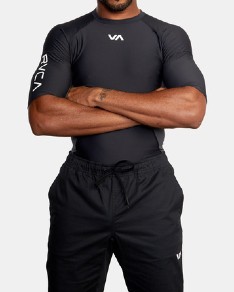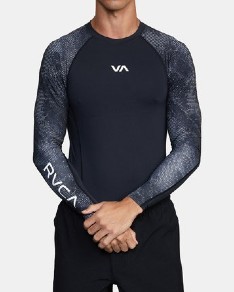How To Choose Compression Clothing
How To Choose Compression Clothing

Compression clothing is stretchy, compressive activewear that improves comfort supports muscle recovery, and enhances performance. Athletes and those who exercise wear compression clothes while doing high-impact sports like running, basketball, cycling and MMA, as well as low-impact sports like strength training, circuit training and stretching.
The following guide covers everything there is to know about compression clothing, from fabrics to fit features, so you can choose the right gear and level up your workout routine.
What Is Compression Clothing?
Compression clothes are made from technical synthetic fabrics like spandex, polyester and nylon. These lightweight, flexible fabrics are durable and can stretch 5 times their size and return to normal.
The tighter blend of fabrics puts added pressure on your muscles which increases the amount of oxygen that enters the bloodstream, which not only helps to maximize workouts but also aids in quicker muscle recovery.
SHOP MEN'S COMPRESSION APPAREL SHOP WOMEN'S COMPRESSION APPAREL
Compression Clothes Benefits
Athletes and those with medical conditions have been using compression technology for years, but anyone can benefit from increased circulation and decreased muscle strain. Read more about how compression clothes can help you in our “Compression Clothes Benefits” guide.
There are a few things to keep in mind when checking out compression clothes. We cover them below.

Get The Size Right
Compression clothes should always be comfortable and never restrict movement. The general rule for sizing is to choose your regular size and consult a size chart if available.
If you’re used to wearing compression clothing, size down for added benefits. If you’re new to compression clothing, choose an in-between size or size up for added comfort.
The general size charts below are a good starting point for choosing the right size compression tops and bottoms. Here are a few tips to consider when measuring:
- Chest: Measure the fullest part of your chest, keeping the tape horizontal.
- Waist: Measure the narrowest part of your waist, where your body bends side to side.
- Hip: Measure the fullest part of your waist.
Men's Tops Size Chart
| SIZE - TOP | XS | S | M | L | XL | XXL |
| CHEST | 36 | 38 | 40 | 42 | 44 | 46 |
| WAIST | 27-28 | 29-30 | 31-32 | 33-34 | 34-36 | 37-38 |
| HIP | 35½ | 37½ | 39½ | 41½ | 43½ | 45½ |
Men's Bottoms Size Chart
| 26 | 28 | 29 | 30 | 31 | 32 | 33 | 34 | 35 | |
| SIZE - BOTTOM | XS | XS | S | M | M | L | L | XL | XXL |
| WAIST | 26 | 28 | 30 | 31 | 32 | 33 | 34 | 36 | 38 |
| HIP | 33½ | 35½ | 37½ | 38½ | 39½ | 40½ | 41½ | 43½ | 45½ |
Women's Tops Size Chart
| SIZE - TOP | XS | S | M | L | XL |
| BUST | 32 - 32½ | 34½ - 35 | 35½ - 36 | 37½ - 38 | 39½ - 40 |
| WAIST | 23 - 24 | 25 - 26 | 27 | 28 - 29 | 30 |
| HIP | 34 - 35 | 36 - 37 | 38 | 39 - 40 | 41 |
Women's Bottoms Size Chart
| SIZE - BOTTOM | XS | S | M | L | XL |
| BUST | 32 - 32½ | 34½ - 35 | 35½ - 36 | 37½ - 38 | 39½ - 40 |
| WAIST | 23 - 24 | 25 - 26 | 27 | 28 - 29 | 30 |
| HIP | 34 - 35 | 36 - 37 | 38 | 39 - 40 | 41 |
Get The Fit Right
Fit is a personal preference, so how your compression clothing fits is completely up to you. There’s no right or wrong.

Tighter-fitting compression clothes increase benefits and highlight the body’s silhouette.

Looser-fitting compression clothes increase range of motion and comfort.
Compression Clothes Essentials
Over the years, compression clothes have grown in popularity and now come in a variety of styles. From compression rash guards to compression socks, a few essentials in your closet can become versatile options for any workout.
T-Shirts & Long Sleeves

Compression shirts are worn not only for their compressive benefits but also because they’re great for layering. If you’re comfortable with the form-fitting nature of compression tees and long sleeves, wear them as outerwear. For more coverage, comfort and warmth, layer up.
Compression Rash Guards

What’s the difference between a compression shirt and a compression rashguard? Compression shirts have a tighter fit and are designed to increase performance and recovery, while compression rashguards have a slightly looser fit and are designed to protect the skin with anti-chafing and UV protection.
Read everything you need to know about "Compression Rash Guards".
Compression Sports Bras

Compression sports bras feature proper chest support to control movement and improve overall comfort. They come in various designs but are most often pullover styles with racerback straps.
For more information on different types of sports bras and their features, check out our informative guide on “How To Choose a Sports Bra”.
Compression Pants

Compression trousers and leggings are skin-tight and place pressure on the waistband, glutes, quads and calves.
They also provide thermal retention, which makes them great for layering beneath gym shorts or joggers.
Compression Shorts

Compression shorts, like other compression garments, are known for their tight, supportive fit that’s designed to reduce muscle strain, increase blood flow and circulation and enhance performance. Compression shorts are ideal for cycling and other aerodynamic sports and can also be found in combat sports like MMA. They can be layered under looser-fitting gym shorts for extra coverage and improved recovery.
Read all about "How To Choose Gym Shorts".
SHOP MEN'S SPORT SHORTS SHOP WOMEN'S SPORT SHORTS
Compression Socks
Compression socks are stretchy, and supportive and reduce swelling in the feet, legs and calves. They provide performance-enhancing comfort during sports and prevent fatigue, muscle soreness and blood clots.
Designed in various lengths to match your activity, compression socks are generally tighter around the ankle and looser up the leg. They can be worn for all types of exercise.
Now that you know what to look for when choosing compression clothing, get ready to take your workout routine to the next level.
Related Guides
Moisture Wicking Clothing Benefits
